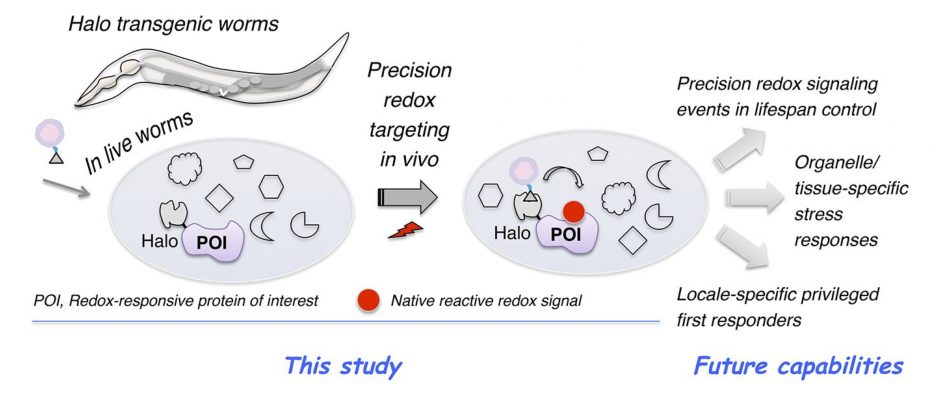September 2017 – Original Research Communication –
“Precision electrophile tagging in C. elegans”
| Selected as an “ACS Editors’ Choice” article! |

Electrophile adduction to privileged sensor proteins and the resulting phenotypically-dominant responses are increasingly appreciated to be essential for metazoan health. Functional similarities between the biological electrophiles and electrophilic pharmacophores commonly found in covalent drugs further fortify the translational relevance of these small-molecule signals. Genetically-encodable or small-molecule-based fluorescent reporters along with redox-proteomics have revolutionized the observation and profiling of cellular redox states and electrophile-sensor proteins, respectively. However, precision mapping between specific redox-modified targets and specific responses has only recently begun to be addressed and systems tractable to both genetic manipulation and on-target redox signaling in vivo remain largely limited. Here we engineer transgenic C. elegans expressing functional HaloTagged fusion proteins and use this system to develop a generalizable light-controlled approach to tag a prototypical electrophile-sensor protein with native electrophiles in vivo. The method circumvents issues associated with low up-take/distribution and toxicity/promiscuity. Given the validated success of C. elegans in aging studies, this optimized platform offers a new lens with which to scrutinize how on-target electrophile signaling influences redox-dependent lifespan regulation.
Marcus J. C. Long#, Daniel A. Urul#, Shivansh Chawla#, Hong-Yu Lin+, Yi Zhao+, Joseph A. Haegele, Yiran Wang, and Yimon Aye*
(#, co-first authors. +, co-second authors. *, corresponding author)
Shivansh is our recently-graduated Cornell undergraduate researcher and 2016 Barry Goldwater scholar, Daniel is one of our graduate student members and an NSF GRFP fellow starting his 3rd year, and Marcus is one of our postdoctoral fellows. Alongside these three co-lead authors, additional contributing authors constitute Hong-Yu and Yi (our respective former and present postdoctoral members), Joe (one of our recently-graduated PhD student members), and Yiran (one of our former Cornell undergraduate researchers).
We thank Professor J. Kelly Liu and Mr. Steve Sammons (Cornell University) for worm genetics technique transfer and generous sharing of the C. elegans microinjection facility.
Functional Halo transgenic worms we have successfully engineered are being deposited to CGC.